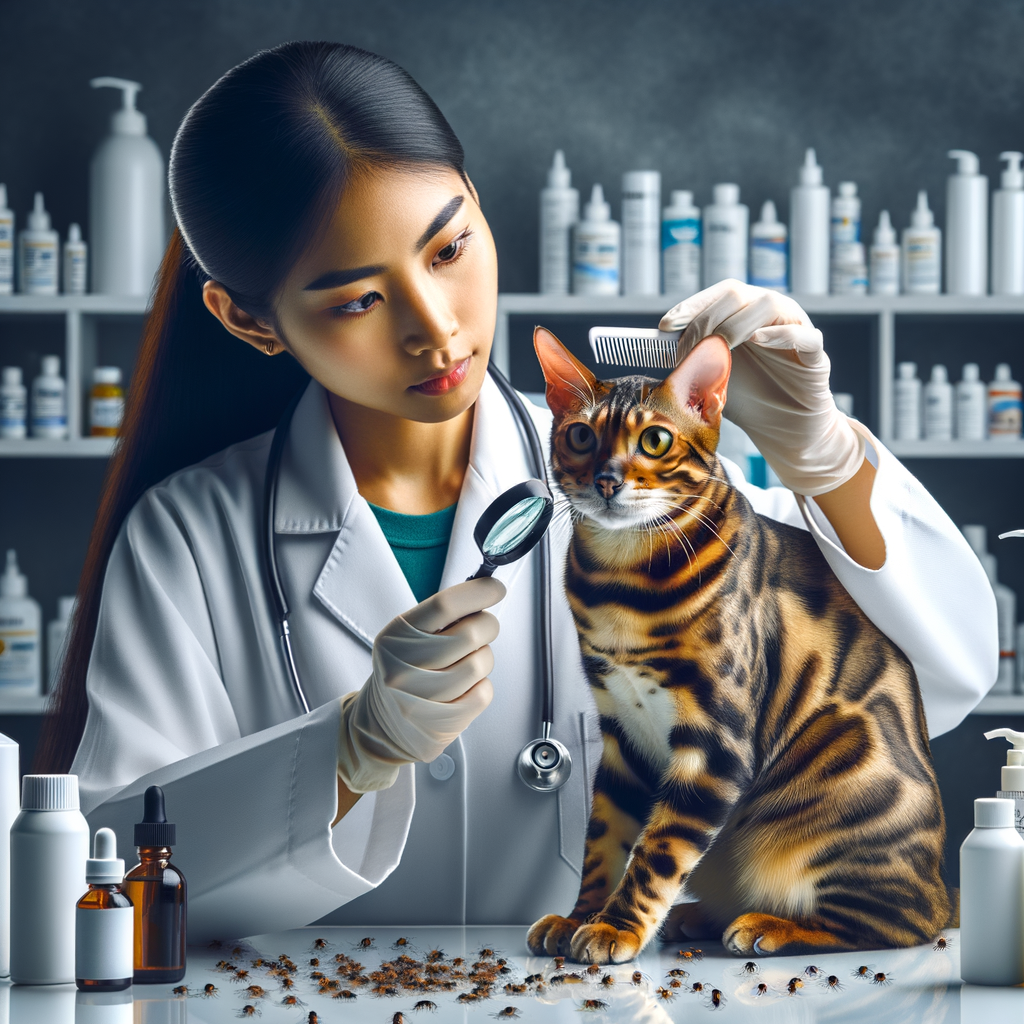
Introduction to Fleas in Bengal Cats
-
Understanding the threat of fleas:
Fleas are tiny insects that feed on the blood of animals. They can cause itching, skin problems, and even diseases. Fleas can jump from one pet to another, making them hard to control. They can also lay hundreds of eggs, which makes them spread quickly.
-
Why Bengal cats are susceptible:
Bengal cats have a unique coat that can make it easier for fleas to hide. Their active nature also means they are more likely to go outside, where they can pick up fleas. Additionally, Bengal cats have a strong immune system, but they can still suffer from flea bites and the problems they cause.
Signs of Fleas in Bengal Cats
-
Identifying flea infestations in Bengal cats
Fleas are tiny insects that can cause big problems for your Bengal cat. They are small, brown, and can jump very far. Look for these signs to know if your Bengal cat has fleas:
-
-
- Scratching and Biting: If your cat is scratching or biting its fur a lot, it might have fleas.
- Red Bumps: Flea bites can cause red bumps on your cat’s skin.
- Flea Dirt: Small black specks in your cat’s fur or on its bedding could be flea dirt, which is flea poop.
- Visible Fleas: Sometimes, you can see the fleas moving in your cat’s fur.
-
-
Common Bengal cat flea symptoms
Fleas can make your Bengal cat very uncomfortable. Here are some common symptoms:
-
- Restlessness: Your cat may seem restless and unable to relax.
- Hair Loss: Fleas can cause your cat to lose patches of fur.
- Scabs and Sores: Constant scratching can lead to scabs and sores on your cat’s skin.
- Anemia: In severe cases, fleas can cause anemia, which makes your cat weak and tired.
How to Check Bengal Cats for Fleas
-
Step-by-step guide to checking your Bengal cat for fleas
- Find a well-lit area: Good lighting helps you see fleas better.
- Part the fur: Use your fingers to part the fur and look at the skin.
- Look for small, dark spots: Fleas are tiny and dark brown. They move quickly.
- Check common areas: Fleas like to hide around the neck, belly, and tail.
- Use a flea comb: A flea comb helps catch fleas and their dirt.
-
Tools you can use
Having the right tools makes checking for fleas easier. Here are some useful tools:
- Flea comb: A fine-toothed comb designed to catch fleas.
- Magnifying glass: Helps you see small fleas better.
- White towel or sheet: Place your cat on a white surface to spot fleas easily.
- Good lighting: Natural light or a bright lamp works best.
Bengal Cat Flea Treatment
Best Flea Treatments for Bengal Cats
Fleas can be a big problem for Bengal cats. They cause itching and can lead to more serious health issues. Here are some of the best flea treatments for Bengal cats:
-
Topical treatments:
These are liquids you put on your cat’s skin. They work fast and can kill fleas within 24 hours. Some popular brands are Frontline and Advantage. Make sure to follow the instructions on the package.
-
Oral medications:
These are pills your cat takes by mouth. They can be very effective and last for a month. Brands like Comfortis and Capstar are well-known. Always talk to your vet before giving your cat any medication.
-
Bengal cat flea medicine:
There are special medicines made just for Bengal cats. These medicines are safe and work well. Your vet can help you choose the right one for your cat.
| Type of Treatment | How It Works | Duration |
|---|---|---|
| Topical treatments | Applied to the skin | Up to 30 days |
| Oral medications | Taken by mouth | Up to 30 days |
| Bengal cat flea medicine | Specially formulated | Varies |
Natural Flea Remedies for Bengal Cats
-
Home Remedies
- Apple Cider Vinegar: Mix equal parts of apple cider vinegar and water. Spray this on your cat’s fur to repel fleas.
- Lemon Spray: Boil a sliced lemon in water, let it sit overnight, and spray it on your cat’s fur.
- Salt: Sprinkle salt on your carpets and furniture. Leave it for a few days, then vacuum it up to kill flea eggs.
-
Natural Products
- Essential Oils: Oils like lavender, eucalyptus, and cedarwood can be mixed with water and sprayed on your cat’s fur. Always dilute essential oils and check with your vet first.
- Diatomaceous Earth: This natural powder can be sprinkled on your cat’s fur and around your home. It kills fleas by dehydrating them.
- Herbal Flea Collars: These collars are infused with natural oils that repel fleas. They are a good alternative to chemical flea collars.
Bengal Cat Flea Prevention
-
Preventive Measures for Flea Control for Bengal Cats
- Regular Grooming: Brush your Bengal cat’s fur often. This helps you spot fleas early.
- Flea Collars: Use a flea collar to keep fleas away. Make sure it fits well.
- Clean Environment: Keep your home clean. Vacuum carpets and wash bedding regularly.
- Flea Treatments: Use vet-approved flea treatments. These can be sprays, drops, or pills.
-
Importance of Regular Check-Ups
- Early Detection: Vets can spot fleas early before they become a big problem.
- Health Monitoring: Regular visits help track your cat’s overall health.
- Professional Advice: Vets can give you the best advice on flea prevention and treatment.
Case Studies: Treating Flea Infestations in Bengal Cats
-
Case study 1: Successful use of topical treatment
Meet Luna, a 3-year-old Bengal cat who had a severe flea infestation. Her owner noticed Luna scratching a lot and saw tiny black specks on her fur. They took Luna to the vet, who recommended a topical treatment.
The vet prescribed a topical medication that needed to be applied once a month. Within a week, Luna’s scratching reduced, and the fleas started to disappear. After two months of consistent treatment, Luna was flea-free.
Key Insight: Topical treatments can be very effective if used regularly and as directed by a vet.
-
Case study 2: Effective natural remedies
Next, we have Simba, a 2-year-old Bengal cat. Simba’s owner wanted to try natural remedies to treat his flea problem. They started by giving Simba regular baths with a mild, flea-repelling shampoo.
Additionally, they used a flea comb daily to remove fleas and their eggs. They also sprinkled food-grade diatomaceous earth around Simba’s bedding area.
After three weeks, Simba’s flea infestation was under control. The natural remedies worked well, and Simba was much happier.
Key Insight: Natural remedies can be effective but may require more time and effort compared to chemical treatments.
Key Takeaways: Bengal Cat Flea Prevention and Treatment
-
Importance of Early Detection
Fleas can cause itching, discomfort, and even serious health issues for your Bengal cat. Regular checks help catch fleas before they become a big problem.
-
Choosing the Right Treatment
There are many flea treatments available. Choose the right one for your Bengal cat. Talk to your vet to find the best option. Treatments can include topical solutions, oral medications, and flea collars.
-
Prevention is Better Than Cure
Regular grooming, cleaning your cat’s bedding, and using preventive treatments can keep fleas away. Prevention helps your Bengal cat stay healthy and happy.
| Key Point | Details |
|---|---|
| Early Detection | Regular checks can catch fleas early and prevent serious health issues. |
| Right Treatment | Consult your vet to choose the best flea treatment for your Bengal cat. |
| Prevention | Regular grooming and cleaning can help prevent flea infestations. |






